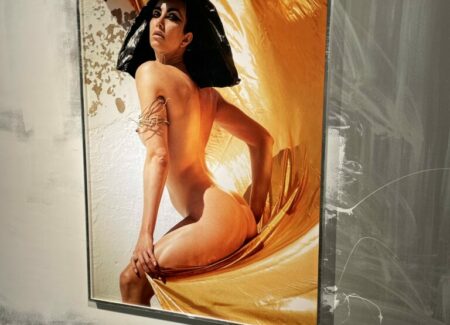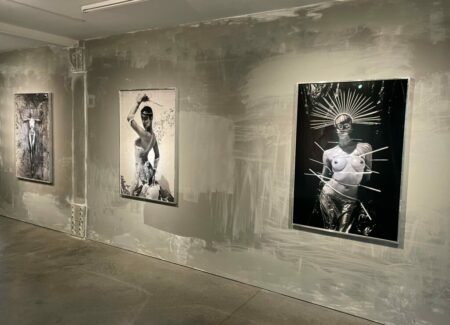JTF (just the facts): A total of 8 large scale black-and-white and color photographs, framed in hand-distressed welded aluminum and unmatted, and hung against roughly painted grey walls (with linen curtains) in the back gallery space. All of the works are c-prints, made in 2021. Physical sizes are either roughly 55×38 inches or 43×65 inches, and all of the prints are available in editions of 7. (Installation shots below.)
This body of work is also concurrently on view at Fraenkel Gallery in San Francisco (here) and Josh Lilley in London. The full collection of 17 portraits will be presented in its entirety for the first time in a traveling museum show, organized by Polygon Gallery, slated for 2024.
A monograph of this body of work has been published by the gallery. (Cover shot below.)
Comments/Context: In our current cultural moment, it would be hard to miss the shift that is taking place toward the broader acceptance of fluidity in gender and identity. And of course, as such cultural shifts gather momentum, they start to brush up against a range of “traditional” beliefs, and the friction gets amplified as the challenge to those ideas becomes more widespread. For those choosing a non-binary identity or making a change or transition from one gender to another, the entrenched images and language that rigidly define “man” and “woman” inevitably feel restrictive, those labels, boundaries, and divisions not offering enough room for alternate lives and experiences.
In just a handful of years, Martine Gutierrez has quickly positioned herself as one of the key contemporary photographic artists actively wrestling these issues. Gutierrez first began to attract attention with a series of staged black-and-white images where she posed herself in fashion-styled setups with various mannequins (both male and female); Gutierrez is a transwoman, and these early images played with a deliberate sense of androgynous glamour, leaning into the complexities of beauty and desire. She followed this up with a powerhouse gallery show in 2018 (reviewed here), where she layered parts of her Guatemalan/Mayan heritage into an evolving exploration of identity, in a multi-faceted project titled Indigenous Woman.
Gutierrez’ most recent efforts continue this upward artistic trajectory with another knockout project, this time centered on spiritual ideals and heroines. The series ANTI-ICON: APOKALYPSIS originally took shape as a commission for Public Art Fund, with her photographs posted on bus shelters in New York, Chicago, and Boston. Gutierrez made seventeen images for the series, each one a role-playing exercise in transformative (and often nude) self-portraiture, with the artist variously portraying notable heroines from across the ages. In taking on the personas of specific goddesses, queens, warriors, saints, and spiritual figures, Gutierrez has repeatedly chosen figures who have stood in opposition to a male-centered world, or refused to acknowledge or adhere to limiting feminine roles or ideals. Her “anti-icons” reveal a reality beyond a simplistic one-dimensional feminine stereotype, where symbols of female (or non-binary) strength, courage, and power come in many forms.
It seems altogether appropriate that a transwoman like Gutierrez would find affinity with figures who have have been composite male-female figures, either as hybrid gendered deities or as women who played the roles of men. Her image as Ardhanarishvara (the Hindu combination of Shiva and Parvati) uses simple black paint as the transforming element, her sinuous body covered and slicked, her hair in a loose twirl, and an array of extra arms taking shape as imprints on the white wall behind her. Her portrayal of Joan of Arc features roughly cut short hair, spray painted golden armor, and a sword made from sticks, her bluntly androgynous bravery presented unflinchingly. And her representation of the Chinese warrior Hua Mulan (who famously disguised herself as a man to fight in battle) uses a plaster cast to re-imagine her body, once again leading to an identity with combined male/female attributes.
This resistance theme is then amplified by two other self-portraits were female beauty is balanced with dominant power. Gutierrez’ image of the biblical Judith, complete with a wire knife stand-in and decapitated head in a plastic bag, matches seduction with aggression, making a boldly sensual statement against the tyranny of the patriarchy. Gutierrez finds a similar tension in her self-portrait as the Egyptian queen Cleopatra, her transformation completed by a trash bag headpiece, a wire arm band, and a sweep of metallic copper drapery; in this image, her nudity is one more a source of commanding power and influence, as is her disdainful glance downward.
The rest of the works included in the show depict more spiritual subjects. Gutierrez as the Virgin Mary riffs on the traditional motif of the cloaked head, wrapping her body from head to toe in glossy black folds. The Syrian fertility goddess Atargatis is recreated with much less modesty, Gutierrez’ nude body covered in shimmery silver and posed as though protectively emerging from a watery void. And her version of Our Lady of Guadalupe features a spiky halo made from plastic zip ties, which bind her nude body while sparkling with lines of light against the darkness.
The larger theme of crafting identity comes through strongly in all of these works, with Gutierrez trying on personas and improvising aspirational looks that amplify certain characteristics of identity. Like Zanele Muholi’s recent self-portraits made from a dizzying array of everyday materials, Gutierrez builds up her radical heroines from modest trappings, each one given life with just a few simple stylistic ingredients or essences. But Guttierez then fills out the presence of these portraits by printing them at near life-sized proportions, rebalancing the relationship between viewer and viewed.
It’s clear that the strongest of these new images (including Cleopatra, Judith, and others) have brashly tapped into the larger movement of gender recalibration taking place around us, and that Gutierrez is cementing her place as a prominent artistic voice for this more inclusive redefinition of self. These works consistently find a seductive sense of dissonance, where femininity and masculinity are elegantly interwoven, opening up more artistic white space for personal identities that don’t adhere to any one set of rules.
Collector’s POV: The prints in this show are priced at $26000 or $28000, based on size. Gutierrez’ work has little secondary market history at this point, so gallery retail likely remains the best option for those collectors interested in following up.















